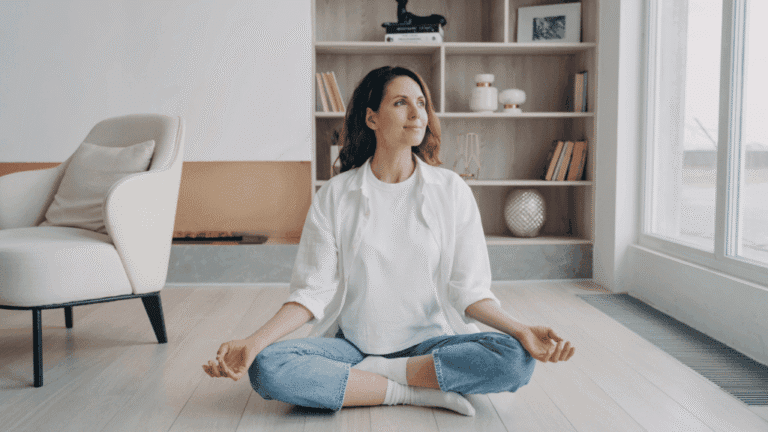Unlock Inner Peace Through Breath Meditation Techniques

In today’s world, finding inner peace can feel hard. But, breath meditation offers a simple way to find calm. By focusing on our breath, we can find peace even in busy days.
Breath meditation, or mindful breathing, comes from ancient traditions. These traditions show how our breath affects our well-being. When we pay attention to our breath, our minds calm down, and our bodies relax. This brings us closer to being fully present and peaceful.
Breath meditation is easy and simple for anyone to start. Just a few minutes a day can bring many benefits. It can help reduce stress, improve focus, and more. The science backs up its power.
If you want to ease the stress of life or find more peace, try breath meditation. It’s a powerful tool for self-discovery and growth. Join us as we dive into breath meditation and discover the peace within us.
Key Takeaways
- Breath meditation involves focusing on the natural rhythm of the breath to achieve inner peace and clarity.
- This ancient practice has roots in Buddhist Anapanasati and Yogic Pranayama traditions.
- Mindful breathing exercises are accessible to everyone and can be practiced anywhere.
- Consistent practice of breath meditation offers numerous physical, mental, and emotional benefits.
- By integrating breath meditation into daily life, individuals can cultivate a greater sense of inner peace and well-being.
Introduction: The Quest for Inner Peace
In today’s fast world, finding inner peace is a common goal. Many people seek a calm and serene life. Meditation is a powerful way to connect with ourselves and find peace.
Breath meditation is especially helpful for stress relief and emotional well-being. It involves focusing on your breath to quiet your mind. This practice helps you become more aware of yourself and leads to deep insights.
Meditation is a way to give your mind a break from the constant chatter and find a place of inner peace.
Studies show meditation has big benefits for our health. It can:
- Reduce stress, anxiety, and depression
- Enhance memory, attention, and problem-solving skills
- Improve emotional regulation and increase self-awareness
- Foster empathy and compassion in relationships
- Promote better sleep quality and overall well-being
For those new to meditation, it’s important to set realistic goals. The effects of meditation may not be seen right away. But with regular practice, you’ll start to notice its positive impact. Breath meditation is a simple way to find peace and balance in life.
| Reasons for Starting Meditation | Percentage of Beginners |
|---|---|
| Stress relief and relaxation | 45% |
| Emotional well-being | 30% |
| Mindful living | 15% |
| Physical health benefits | 7% |
| Spiritual growth | 3% |
As we dive deeper into breath meditation, we’ll look at different techniques and benefits. We’ll see how it can help you find peace and handle life’s challenges better.
Understanding Breath Meditation
Breath meditation is a deep practice that helps us focus inward and connect with our breath’s power. It makes us mindful and aware of the present moment. This simple practice can bring us inner peace and improve our overall well-being.
What is Breath Meditation?
Breath meditation is about paying attention to how the breath moves in and out of our body. We can focus on the air moving through our nostrils or the rise and fall of our abdomen. The goal is to watch the breath without judging it or trying to control it. This helps us find inner stillness and peace.
This practice is easy and simple, needing no special tools or experience. It’s open to everyone, whether you’re new to meditation or have been doing it for years. The breath is always there to help us stay in the moment.
The Roots of Breath Meditation in Ancient Practices
Old traditions have long known how important conscious breathing is for our health. In Buddhism, Anapanasati, or “mindfulness of breathing,” has been a key practice for centuries. It helps us find peace and spiritual growth by making us aware of our breath.
“Breathing in, I calm my body. Breathing out, I smile. Dwelling in the present moment, I know this is a wonderful moment.” – Thich Nhat Hanh
In Yoga, Pranayama, or breath control, is also crucial. These exercises change the breath to balance the body, mind, and emotions. Yogis use the breath to clean the body, calm the mind, and connect with their true self.
| Ancient Practice | Key Focus | Benefits |
|---|---|---|
| Buddhist Anapanasati | Mindfulness of breathing | Develops insight, concentration, and equanimity |
| Yogic Pranayama | Breath control exercises | Promotes physical, mental, and emotional balance |
By learning from these old practices, breath meditation gives us a timeless way to find peace and well-being. As we practice, we connect with the wisdom of the past and start a journey of self-discovery and growth.
Types of Breath Meditation Techniques
Breath meditation is a powerful tool for inner peace and stress reduction. There are various breathing techniques that help you focus on your breath. These techniques can improve your awareness and bring you peace.
Mindfulness of Breathing (Anapanasati)
Mindfulness of Breathing, or Anapanasati, is a simple yet powerful technique. It involves focusing on your natural breath without trying to change it. This practice helps you connect deeply with the present moment. It can calm your mind, reduce stress, and improve your well-being.
A 2020 study found that deep breathing can switch your body from stressed to calm.
Diaphragmatic Breathing
Diaphragmatic breathing, also known as belly breathing, fills your lungs and expands your diaphragm. This technique is great for relaxation, stress reduction, and building confidence. By focusing on your diaphragm, you can improve your breath awareness and lung function.
Start with 1 to 4 times per day, 5 to 10 minutes each session.
Box Breathing
Box breathing is a structured technique that involves inhaling, holding, exhaling, and holding again for equal counts. It can calm your mind, improve focus, and balance your emotions. Box breathing is useful in stressful situations, offering a controlled breathing method.
Beginners should practice for 5 to 7 minutes and increase as they get more comfortable.
Alternate Nostril Breathing (Nadi Shodhana)
Alternate Nostril Breathing, or Nadi Shodhana, involves inhaling through one nostril and exhaling through the other. This technique balances your nervous system, enhances mental clarity, and promotes equal breathing. It’s known for calming effects and can help reduce anxiety and improve sleep.
| Technique | Benefits | Practice Duration |
|---|---|---|
| Mindfulness of Breathing | Stress reduction, increased well-being | 5-7 minutes for beginners, gradually increase |
| Diaphragmatic Breathing | Relaxation, confidence boost, improved respiratory function | 1-4 times per day, 5-10 minutes each |
| Box Breathing | Calmness, improved focus, sense of balance | 5-7 minutes for beginners, gradually increase |
| Alternate Nostril Breathing | Balanced nervous system, mental clarity, reduced anxiety, improved sleep | Daily practice, 5-10 minutes each session |
Deep breathwork daily can relax the mind and body, decrease stress, anxiety, and improve sleep.
Adding these breath meditation techniques to your daily routine can bring you peace and well-being.
The Benefits of Breath Meditation
Starting breath meditation opens up many benefits that go beyond just the practice. By spending a few minutes each day on mindful breathing, you gain a deep sense of peace. This peace touches every part of your life.
Physical Benefits
Breath meditation is great for your body. It makes your lungs and diaphragm stronger. This means better breathing and more oxygen in your body.
This can lower your blood pressure and cut down the risk of heart disease. It also helps your immune system work better, fighting off sickness. By easing stress, it helps your body heal and feel new again.
“The breath is the bridge which connects life to consciousness, which unites your body to your thoughts.” – Thích Nhất Hạnh
Mental and Emotional Benefits
Breath meditation also helps your mind and feelings. It makes you less anxious and stressed. This calm lets you handle life’s problems better.
It makes you more focused and sharp. You’ll think clearer and be more aware of your feelings. This helps you deal with people and everyday life more smoothly.
| Benefit | Description |
|---|---|
| Stress Reduction | Breath meditation reduces stress and helps you relax deeply. |
| Improved Respiratory Function | It makes your lungs and diaphragm stronger, improving your breathing. |
| Lowered Blood Pressure | It helps lower blood pressure, reducing heart disease risk. |
| Enhanced Immune System | It helps your immune system work better, fighting off sickness. |
| Reduced Anxiety | Focusing on your breath calms your mind and lowers anxiety. |
| Improved Focus | It makes you more focused and sharp, improving your thinking. |
| Emotional Regulation | It helps you understand and manage your feelings better. |
| Overall Well-being | Adding breath meditation to your life improves your overall well-being. |
As you get better at breath meditation, you’ll feel a big change in your life. You’ll be more peaceful and strong inside. This helps you handle daily challenges with ease. Let breath meditation change you for the better.
Getting Started with Breath Meditation
Starting a breath meditation journey can change your life. It helps you find peace and be more mindful. Just 12 minutes a day, 5 days a week, can improve your focus and connect you with the present.
Preparation
Here’s how to prepare for breath meditation:
- Find a quiet spot where you won’t be distracted.
- Sit comfortably, with your back straight and body relaxed.
- Think about what you want from your meditation, like less stress or better focus.
- Close your eyes to focus inside and ignore distractions.
Step-by-Step Guide
Ready to start? Here’s how to begin your meditation:
- Breathe deeply to calm down and relax your body.
- Let your breath go back to its natural pace, without trying to control it.
- Pay attention to how your breath feels as it moves in and out, or the belly’s rise and fall.
- If your mind wanders, bring it back to your breath with a simple thought.
- Don’t try to clear your mind completely. Just focus on staying with your breath.
- Start with short sessions and increase time as you get more comfortable.
“Breathe, and know you are breathing.” – Thich Nhat Hanh
Be patient and kind to yourself as you start. It’s normal for your mind to wander. Every time you bring your focus back, you’re getting better at mindfulness. With regular practice, you’ll feel more aware of your breath and more at peace every day.
| Resource | Description |
|---|---|
| Headspace | Popular meditation app offering guided sessions |
| 10% Happier | Meditation app with guided sessions and courses |
| Insight Timer | Free app with a wide variety of meditation practices |
| Calm | App focused on meditation and sleep |
| “10% Happier” by Dan Harris | Book exploring the author’s journey with meditation |
| “Wherever You Go, There You Are” by Jon Kabat-Zinn | Book offering insights into mindfulness and meditation |
| “Real Happiness: The Power of Meditation” by Sharon Salzberg | Book with a 28-day program for developing a meditation practice |
Integrating Breath Meditation into Daily Life
Adding breath meditation to your daily life is key to feeling its deep benefits every day. By adding mindful breathing to daily tasks, you can grow a peaceful and present mindset. With simple steps and sticking to them, you can turn your days into a journey of calm and breath awareness.
Practical Tips for Integrating Breathing Meditation into Everyday Activities
Linking breath meditation to your daily habits is a great way to keep it up. This method, called habit stacking, makes it easy to practice without feeling stressed. Start your day with mindful breathing or take a short break during lunch. Use times like waiting in line or commuting to focus on your breath and be more mindful.
Short Breathing Exercises for Busy Schedules
Even with a busy life, short breathing exercises can make a big difference. These breaks can lower stress, boost focus, and keep you calm. Here are some exercises to try:
- One-Minute Breath Awareness: Close your eyes and focus on your breath for one minute, noticing each inhale and exhale.
- Three Deep Breaths: Take three slow, deep breaths, inhaling through your nose and exhaling through your mouth. Feel the tension leave with each breath.
- 5-5-5 Breathing: Inhale for a count of five, hold your breath for five, and exhale for five. Repeat this cycle to relax.
Using Reminders and Triggers
Reminders and visual cues can help you remember to meditate regularly. Set alarms on your phone or computer for mindful breaks. Place sticky notes in places you’ll see them, like on your mirror or desk. Having a special spot for meditation at home, like a cozy corner with calming lights, can also remind you to breathe deeply.
“Breath is the bridge which connects life to consciousness, which unites your body to your thoughts.” – Thich Nhat Hanh
By making breath meditation a part of your daily life, you start a journey to inner peace and well-being. As you keep practicing, you’ll feel more present, resilient, and connected to now. Let your breath guide you, and see how it brightens every part of your life.
Overcoming Common Challenges
Starting your breath meditation journey can be tough. You might face distractions, restlessness, and physical discomfort. But with patience, consistency, and the right mindfulness techniques, you can beat these issues and keep a regular practice.
One big challenge is a wandering mind. Our thoughts often jump to the past or future, making it hard to stay in the moment. In fact, most of our time is spent thinking about something other than now. If your mind wanders during meditation, gently bring it back to your breath. Don’t be too hard on yourself; even experts have trouble staying focused.
Restlessness, both in your mind and body, is another hurdle. If you can’t stop fidgeting or feel restless, pay attention to your body’s sensations. Take deep breaths and try to relax. If you’re still restless, start with shorter sessions and slowly increase the time. For more tips, check out this article from Headspace.
Physical discomfort can also happen during meditation, like itching or pain. It’s easy to want to move, but try to watch the sensation with curiosity. See how it changes and breathe into it. If it’s too much, you can adjust your position carefully.
“Meditation is a practice, and like any practice, it takes time to develop. Be patient with yourself and celebrate the small victories along the way.”
Being consistent is crucial to get past meditation obstacles. Try to meditate regularly, even if it’s just a few minutes a day. Over time, you’ll get better at handling challenges. Every meditation session is a chance to learn more about yourself and find peace.
For more advice on overcoming challenges, see this resource from SpiritualOut. With commitment and the right tools, you’ll soon have a powerful breath meditation practice.
The Power of Breath Meditation Retreats
Going to a meditation retreat can change your life. It’s a chance to dive deep into breath meditation. You’ll meet people who also love inner growth and well-being. This community support helps you stay on track with your meditation.
Experienced teachers at these retreats guide you. They give personal advice and insights. This helps you improve your meditation skills and understand it better. You’ll learn new ways to meditate that fit you best.
Retreats offer a peaceful place to focus on meditation. You can leave daily life behind. This lets you fully be in the moment. You might feel less stressed and more peaceful.
But the good stuff doesn’t stop after the retreat ends. Studies show that regular meditation can really help your mental health. For example:
| Benefit | Research Findings |
|---|---|
| Depression Relief | SKY Breath Meditation has a 68-73% success rate in treating depression, with substantial relief experienced in just three weeks of practice. |
| Trauma Healing | SKY Breath is a powerful tool for healing mild to severe trauma, such as PTSD symptoms. Veterans who practiced SKY Breath reported significant reductions in anxiety and improvement in PTSD symptoms. |
| Hypertension Management | Regular practice of rhythmic breathing, like SKY Breath, balances the autonomic nervous system, benefiting individuals with hypertension. |
| Immune Function | The practice of SKY Breath is associated with improved immune function, indicated by increased natural killer cells among cancer patients after 12 and 24 weeks of practice. |
Besides health benefits, these retreats let you meet others like you. Sharing your journey with them can be uplifting. You might make friends and feel like you belong.
“The depth of insight during meditation, known as Laktong, can be enhanced by increasing the time dedicated to the practice.” – Tai Situpa Rinpoche
As you keep practicing, meditation’s benefits can spread into your everyday life. You’ll feel more aware, strong emotionally, and peaceful inside. This makes dealing with life easier and more meaningful.
Breath Meditation and Mindfulness
Breath meditation and mindfulness work together to bring us inner peace and self-awareness. By focusing on our breath, we stay in the moment. This lets us watch our thoughts and feelings without judging them. Non-judgmental observation is key to mindful living, helping us stay calm and clear-headed.
The Connection Between Breath and Mindfulness
The breath connects our body and mind, making it perfect for mindfulness. When we pay attention to our breath, we become more aware of the present. This helps us quiet our minds and connect with ourselves.
Studies show that mindfulness can really help us. A 2021 study found it made women in Iran more resilient. Another study in 2019 showed it helped people with rheumatoid arthritis feel better.
Cultivating Mindfulness Through Breath Meditation
Practicing breath meditation makes us better at living mindfully. It brings us into the present and helps us stay balanced. By using the right breathing techniques, we improve our well-being, as experts like Shilagh Mirgain, PhD, explain.
“Breath meditation is a powerful tool for cultivating mindfulness and inner peace. By anchoring our awareness in the present moment through the breath, we learn to observe our experiences with kindness and compassion, fostering a deeper sense of self-awareness and emotional balance.”
Breath meditation does more than just reduce stress. A 2012 study looked at how it helped gay men with HIV. Another study in 2020 found it helped survivors of intimate partner violence.
| Study | Year | Key Findings |
|---|---|---|
| BMC Women’s Health | 2021 | MBSR enhances resilience in vulnerable women |
| Mindfulness | 2019 | MBSR improves quality of life in rheumatoid arthritis patients |
| Controlled Trial | 2012 | MBSR manages affective symptoms in gay men with HIV |
| Psychological Trauma: Theory, Research, Practice, and Policy | 2020 | Mindfulness training reduces posttraumatic stress in intimate partner violence survivors |
| The Journal of Alternative and Complementary Medicine | 2015 | MBSR decreases depression symptoms, moderated by various factors |
Embracing breath meditation leads us on a journey of self-discovery and peace. Through daily life’s ups and downs, the breath guides us back to now. With each mindful breath, we grow closer to ourselves and the world, living more compassionately and fully.
Breath Meditation for Stress Relief
In today’s fast-paced world, managing stress is key to staying well. Breath meditation is a powerful way to relax and lessen stress. By focusing on deep, mindful breathing, you can trigger your body’s natural calm response. This leads to a deep sense of peace and tranquility.
Breath meditation means controlling your breathing, usually by taking slow, deep breaths from the diaphragm. This activates the parasympathetic nervous system, which helps you relax. It lowers stress hormones like cortisol, helping your body and mind relax and balance.
Breath meditation is easy to do anywhere, anytime. You can practice it for a few minutes during a busy day or for longer in the evening. Everyone can benefit from it.
“Breath is the bridge which connects life to consciousness, which unites your body to your thoughts.” – Thích Nhất Hạnh
Regular breath meditation helps with stress now and builds long-term resilience and emotional health. By doing it often, you get better at handling anxiety and staying calm through life’s ups and downs.
| Breathing Exercise | Duration | Benefits |
|---|---|---|
| Deep Breathing | 5-10 minutes | Reduces stress, lowers heart rate |
| Box Breathing | 5 minutes | Calms the mind, promotes focus |
| Alternate Nostril Breathing | 5-10 minutes | Balances brain hemispheres, reduces anxiety |
To start with breath meditation, follow these tips:
- Make time for it, even just a few minutes a day.
- Choose a quiet spot where you won’t be distracted.
- Start with simple methods like counting breaths or feeling the air move in and out.
- Be gentle with yourself if your mind wanders, and bring it back to the breath.
Embracing breath meditation opens up a world of peace, resilience, and well-being. As you begin this journey, remember that each breath is a chance to reconnect with yourself. With regular practice, you’ll see that managing stress and finding calm is as simple as mindful breathing.
Breath Meditation and Emotional Well-being
Beyond just reducing stress, breath meditation helps with emotional health. It teaches people to manage their feelings better, leading to more stable moods and less anxiety. It helps you watch your feelings without getting caught up in them. This builds self-compassion and inner strength.
Studies show how mindfulness and meditation help with emotional health. A study on Chinese nursing students found less anxiety and lower blood pressure from meditation. Another study in Korea showed less stress, anxiety, and depression in nursing students who practiced mindfulness meditation.
Managing Anxiety with Breath Meditation
Breath meditation is great for handling anxiety. It makes you focus on your breath, leading to calmness and less stress. This slows down your heart rate and lowers stress hormones. Regular practice builds emotional strength to handle stressful situations better.
| Study | Findings |
|---|---|
| Mindfulness model of affect regulation and depressive symptoms | 49% reduction in depressive symptoms observed |
| Effects of covid-19 on college students’ mental health in the United States | Considerable increase in anxiety and depression |
| Mindfulness, happiness, and anxiety in a sample of college students | Positive impacts on emotional well-being |
Cultivating Emotional Resilience
Breath meditation helps build emotional resilience. It makes you more aware of your feelings and emotions. This lets you handle life’s ups and downs more easily. It also teaches self-compassion, so you’re kind to yourself when things get tough.
Mindful breathing has various benefits including stress reduction, anxiety alleviation, depression management, improved sleep quality, pain reduction, enhanced focus, concentration, productivity, relaxation, and mindfulness awareness.
Adding breath meditation to your daily routine can greatly improve your emotional health. Even just 5-10 minutes a day can make a big difference. As you keep practicing, you’ll find it easier to manage your emotions, stay calm, and feel more resilient.
Conclusion
Breath meditation is a transformative journey that leads to inner peace, self-discovery, and mindful living. It helps us become more aware of our breath and use it to improve our well-being. Studies show it can reduce stress, anxiety, and depression, and boost our focus and accuracy.
By practicing regularly, breath meditation helps us handle life’s ups and downs better. It connects us to the now and helps us find our inner peace and wisdom. Research shows it benefits many people, like those with autism, borderline personality disorder, and veterans with PTSD. More studies are finding out how it changes our bodies and minds.
With effort and commitment, breath meditation can change lives, bringing peace, harmony, and connection. By making it a daily habit, we improve our lives and help our communities. This practice invites us to explore ourselves, find peace in the moment, and live more mindfully and kindly.
















